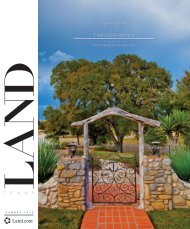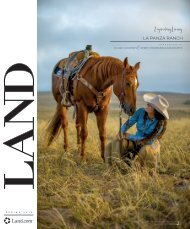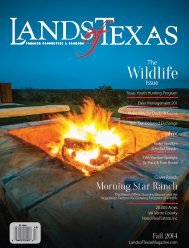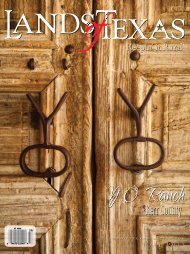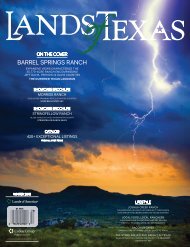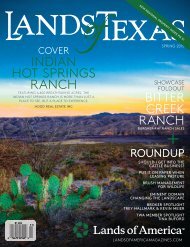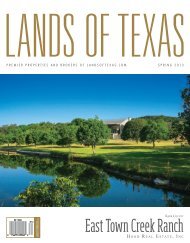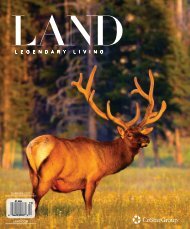Create successful ePaper yourself
Turn your PDF publications into a flip-book with our unique Google optimized e-Paper software.
SPORTING ISSUE<br />
Winter<br />
<strong>Texas</strong>' Best All-Around<br />
Wildlife Food Plot<br />
was a similar phone call as many others that<br />
I’ve received over the years. “We have been<br />
trying to establish some wildlife food plots<br />
over the years, using some of the more popular crops<br />
that are on the market. Other than one year, we have<br />
had very little success getting much results from our<br />
efforts and it seems like the return on our investment is<br />
questionable, at best.” After an additional five minutes<br />
of Q&A, it was apparent that their efforts were destined<br />
for marginal results from the get-go. Located in Coke<br />
County, the property that was high-fenced about seven<br />
years earlier, is in a semi-arid 20” annual rainfall belt,<br />
the soils they were planting were marginal for farming,<br />
the multiple variety of legumes they were planting were<br />
likely being prematurely killed by heavy grazing from<br />
deer since the fields could not be temporarily highfenced,<br />
and no fertilizer was being applied. The one year<br />
they had “good results” was in 2010, which happened<br />
to be an exceptionally wet year. Truth be known, they<br />
would have been better off to have put that money<br />
and effort into pelleted feed; their expensive forage<br />
enhancements strategies were flawed and did not match<br />
up well with the variety of crops that they were planting.<br />
Food plots have been a hugely popular deer management<br />
practice in various areas of the U.S. for over two decades,<br />
including <strong>Texas</strong>. Three main limiters when it comes<br />
to food plot success is farming technique including<br />
equipment, soil characteristics, and moisture. The first<br />
two of these limiters can be sometimes be controlled or<br />
manipulated to some extent. The third variable, however,<br />
is generally outside of the manager’s hands, unless they<br />
have irrigation capabilities. Here in <strong>Texas</strong>, perhaps as<br />
much as 90 percent of the food plots that are planted<br />
for wildlife do not have irrigation facilities in-place. And<br />
though there are a wide assortment of warm season, cool<br />
season, and perennial type plants available on the market,<br />
the reality is that most wildlife managers are not farmers,<br />
and many of these plant varieties demand astute farming<br />
applications to realize the full benefits of those costs.<br />
Winter Wheat<br />
Though not as “sexy” as some of the other more popular<br />
and expensive wildlife crops, Texans will be hard pressed to<br />
find a cover crop that is more practical and universal than<br />
winter wheat. In the cereal grain or short grain family, this<br />
plant is relatively drought hardy, often performing well in<br />
rainfall belts as low as 17–18”. Wheat is relatively graze hardy<br />
and can withstand grazing pressures from deer and even<br />
cattle during its early stages without killing it out, it does<br />
not require as much farming expertise as some plants, it<br />
can grow in fairly diverse soil types, and wheat has multiple<br />
benefits and applications for a variety of wild critters.<br />
There are various strains of winter wheat on the market, but<br />
the general rule of thumb is to utilize one of the awnless<br />
strains, as they are a bit more attractive to wildlife during the<br />
seedhead stage. From a nutritional standpoint, wheat offers<br />
two tiers of benefits for some species of wildlife. During the<br />
growing stages, the leafy portions of the plant are highly<br />
palatable and provide upwards of 20 percent crude protein,<br />
with fiber levels that may run 25 percent until stem elongation.<br />
Energy levels of the seedheads are comparable to corn or<br />
grain sorghum, and crude protein of the seeds will generally<br />
run about 12 percent. A host of wildlife species consume<br />
wheat at different stages of plant growth, including various<br />
songbirds, gamebirds, rabbits, squirrels, and deer. Standing<br />
mature wheat during the late portion of the summer can also<br />
provide excellent protective and loafing cover for broods of<br />
quail and turkeys, as well as reptiles, and other wildlife.<br />
Planting<br />
Wheat is relatively easy to plant and establish. For those who<br />
are lacking much farming equipment, especially if the plots<br />
are less than a few acres in size, soil preparation may be as<br />
simple as discing to create exposed loose soil, broadcasting,<br />
then dragging the surface to create a seedbed. However,<br />
better yet, is to properly prepare the soil, and then plant the<br />
seeds using a seed drill. A benefit of the drill is ensuring<br />
better consistency of planting distribution, plus the furrow<br />
rows allow for better interstitial spacing between plants<br />
102




